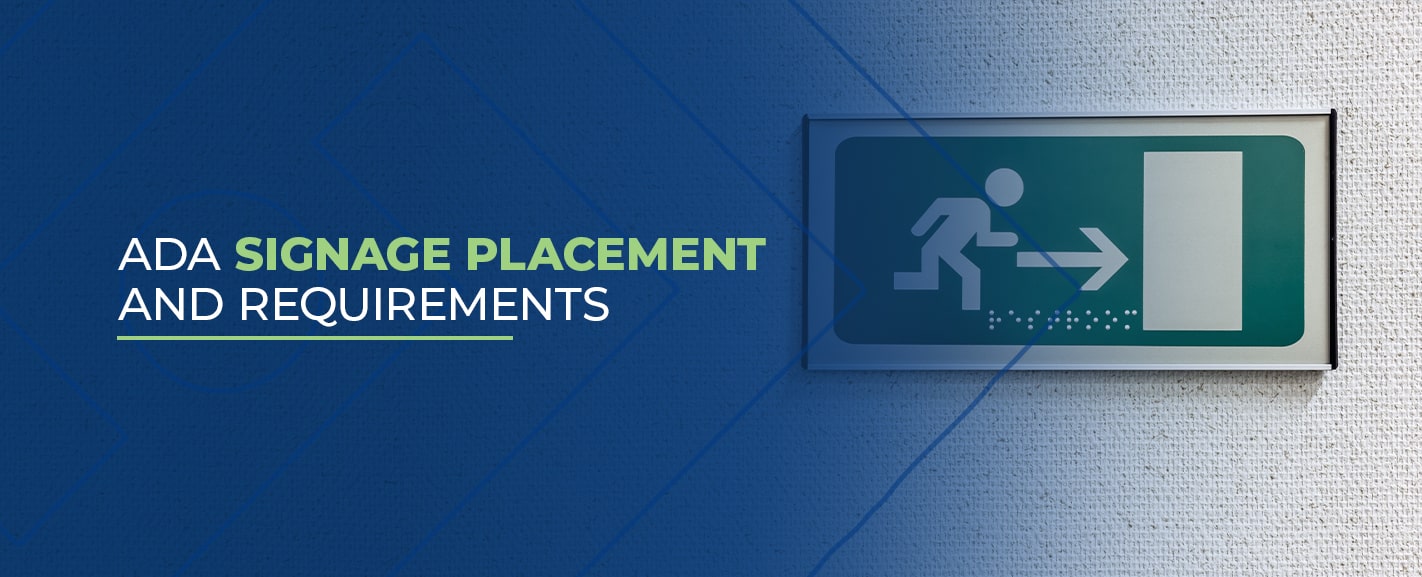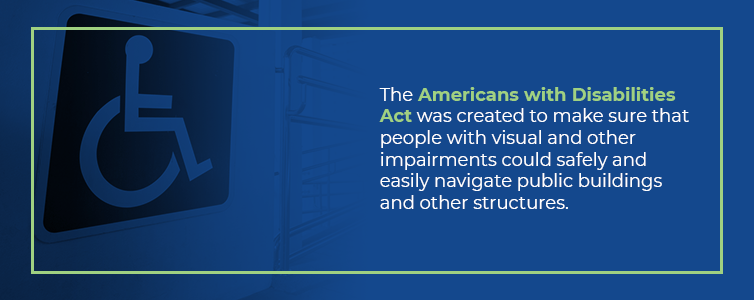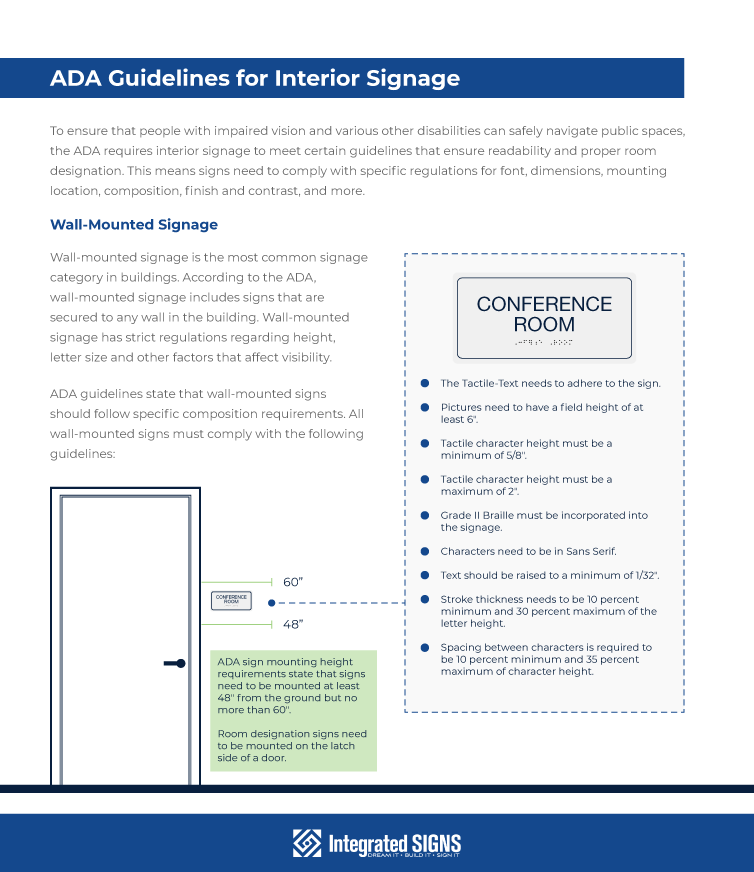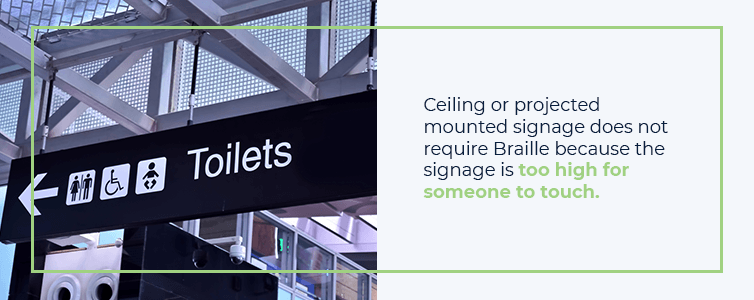- November 13, 2019

ADA Signage Placement and Requirements
Signs are everywhere. From company entrances to restrooms, signage is a standard part of building construction. In any commercial structure, signs are used to designate specific places and guide people through the building. They also have to be readable and accessible to any person who enters the building.
The Americans With Disabilities Act (ADA) establishes guidelines that a business’s signage must follow to ensure it is easily identifiable by people across the disability spectrum. These guidelines are designed so that every person who enters a building can safely navigate the building’s interior and easily find their way back out.
From conference room signs to exit signs and more, every type of signage needs to comply with state and federal regulations that are applicable. This includes signs in business offices, public places, schools, medical buildings and much more. Failure to comply with the now federally enforceable ADA guidelines could result in the injury of a person visiting the building, along with lawsuits, investigations and other consequences.
ADA signage regulations, also known as code signage, may sound like a daunting hurdle to some, but they are fairly easy to implement. The following ADA sign requirements provide a simple outline of code signage requirements for common signs seen in most public buildings.
But first, it is important to understand the basics of the ADA.
Table of Contents
- What Is the Americans With Disabilities Act?
- Why It’s Important to Have ADA-Compliant Signage
- Types of Signage That Must Be ADA-Compliant
- How to Determine Whether or Not a Room Is Permanent or Temporary
- ADA Guidelines for Interior Signage
- Design Tips for ADA Signage
- Frequently Asked Questions About ADA Signage
- Choose Integrated Sign Associates for Your ADA-Compliant Signage Needs
What Is the Americans With Disabilities Act?
The Americans With Disabilities Act was created to make sure that people with visual and other impairments could safely and easily navigate public buildings and other structures. The ADA prohibits discrimination against people with disabilities by employers, public accommodations, commercial facilities and more. For businesses, this means signs need to meet certain technical specifications to be ADA-compliant. For example, all signs must have easily readable graphics, and they must be mounted within everyone’s line of sight. ADA exterior sign requirements include signs for all entries and exits to the building, with accessibility symbols for accessible parking spaces, passenger loading zones and accessible entrances.
The ADA also authorizes the U.S. Department of Justice to regulate code signage and determine whether states, building codes and comparable ordinances meet ADA standards.
Why It’s Important to Have ADA-Compliant Signage
Providing ADA-compliant signage is a legal obligation mandated by the federal government. Failure to provide ADA signage could result in litigation and fines. You should also research your state or municipal regulations on accessibility to ensure you comply on all legal levels.
Beyond the legal requirement, ADA signage sends an important message to the people who use the space, both as customers and employees. The appropriate, compliant signage helps people with disabilities access your space safely. Without signs, you are excluding a potential group of customers and demonstrating to employees you do not prioritize accessibility. ADA signage is essential to maintaining safety for your employees, customers and others who do business with your company. These signs also show that you are active in helping your community.
Types of Signage That Must Be ADA-Compliant
Unless you work in construction or building regulation, you may be surprised to learn how many signage varieties exist in public spaces. The ADA now requires that every permanent space or room in a building incorporates ADA-compliant signs. Each space must also undergo a stringent construction and building process to ensure it is ready for use.
If you are constructing a building or simply want to make sure your business or facility is ready to pass an ADA inspection, you need to consider the following types of signs and their designated purposes in any facility. These types of signs can be regulated by the ADA:
- Restroom signs: One of the most commonly recognized signage codes is the restroom designation, which contains both words and universal symbols.
- Permanent room identification signs: Permanent room identification signs are part of a broad category that could represent any permanent room in a building, including an office, conference room, break room or lobby.
- Building exit signs: Building exit signs are usually ceiling-mounted or overhanging signs that designate the fastest and safest ways to exit a building.
- Restricted access signs: It is important to designate restricted access areas in a building. Clearly indicating that certain areas are off-limits to the public saves people from injury and businesses from potential property damage.
- Directional signs: Especially in large buildings like hospitals and schools, directional signs are necessary for helping people find their way around a vast and often confusing building layout.
- Parking lot signs:In general, businesses with their own parking lots need to include spaces designated for accessible parking. These spaces must be identified with the universal handicap symbol.
- Emergency signs: The ADA requires that all buildings subject to ADA compliance feature appropriate emergency signage, including emergency exit signs, elevator emergency signs and other related signage.
Different types of signage will require different technical specifications. It is crucial to create and place signs according to their purposes to ensure all your signage complies with ADA regulations and all state building codes.
How to Determine Whether or Not a Room Is Permanent or Temporary
Any permanent room in a public building must be marked with ADA signs, so how can you determine if a room is considered permanent or temporary? A permanent room is generally considered a space with a function that cannot be easily changed. For example, a restroom in a public building is considered a permanent space. Something like a pop-up exhibit or classroom is likely considered to be temporary. While there may be some grey area in determining permanent versus temporary, considering the construction of the space can be helpful. If the space has walls connected to the ceiling, it is probably a permanent space that must have ADA-compliant signage.
ADA Guidelines for Interior Signage
To ensure that people with impaired vision and various other disabilities can safely navigate public spaces, the ADA requires interior signage to meet certain guidelines that ensure readability and proper room designation. This means signs need to comply with specific regulations for font, dimensions, mounting location, composition, finish and contrast.
Under the ADA’s Standards for Accessible Design (SAD), as of March 2011, compliance with the following design standards is federally enforceable.
1. Wall-Mounted Signage
Wall-mounted signage is the most common signage category in buildings. According to the ADA, wall-mounted signage includes signs that are secured to any wall in the building. Wall-mounted signage has strict regulations regarding height, letter size and other factors that affect visibility.
Categories of Wall-Mounted Signage
Wall-mounted signage includes a variety of categories, and the ADA covers the following categories:
- Identification of permanent room signs: These signs cover room designations that are not likely to change. Permanent room signs can include bathroom signs, office numbers, conference room signs and other permanent room signs.
- Directional signs: Directional signs are designed to help people navigate through buildings and find specific rooms or other areas. They are typically located at building entrances or hallway intersections.
- Informational: Informational signs are common in places like museums, galleries and other educational centers, but they can be found anywhere. Informational signs are designed to provide important information about a specific thing or place within a building.
Mounting Signage on the Wall
Wall mounting standards refer to where wall signs are placed. The ADA requires the following:
- Room designation signs need to be mounted on the latch side of a door.
- ADA sign mounting height requirements state that signs need to be mounted at least 48 inches from the ground but no more than 60 inches.
Finish and Contrast of Wall-Mounted Signage
The ADA has the following signage finish and contrast guidelines to ensure the text is clearly visible from far away:
- Characters need to contrast with their backdrop.
- Finish should be eggshell, matte or another non-glare finish.
2. Ceiling or Projected Mounted Signage
Ceiling or projected mounted signage does not require Braille because the signage is too high for someone to touch. However, this category of signage has requirements similar to wall-mounted signage.
Categories of Ceiling or Projected Mounted Signage
Ceiling or projected mounted signage usually come in directional or informational signs. They follow most of the same regulations as wall-mounted signs, with some exceptions.
Composition of Ceiling or Projected Mounted Signage
Ceiling-mounded signage has some special considerations, such as:
- Ceiling signs do not need to use Braille.
- If the sign is more than 10 feet from the ground, a 2-inch character minimum is required.
Mounting Ceiling or Projected Mounted Signage
The ADA requires that ceiling or projected mounted signs must be at least 80 inches of above the floor to give people adequate headroom.
Finish and Contrast of Ceiling or Projected Mounted Signage
Ceiling or projected mounted signs have certain requirements to ensure visibility, including:
- As with ADA wall-mounted signage, characters must contrast with their background enough to be visible from several meters away.
- Characters should have non-glare finishes, such as matte or eggshell.
Design Tips for ADA Signage
Your ADA signage should meet all regulations and requirements when considering design options. While the ADA requirements are in place to ensure that the information on the sign is readable and easy to understand, these rules also help make the sign visually appealing. Use these tips to create a sign that will be useful and comply with the rules set by the ADA:
- Minimize the glare: A high-gloss finish in your signage might seem appealing, but it can result in a glare that makes it difficult to read. This often happens when signage has a shiny finish and has sunlight or artificial building lights reflect off the sign’s surface. Glare should be minimized on ADA-compliant signs. Ask your signage company to include a non-glare finish to all your signage that must comply with ADA requirements.
- Elevated lettering: ADA signage should include lettering that is tactile — raised — and have Braille lettering to ensure individuals who are visually impaired can understand the information on the sign. The Braille on your sign will need to be Grade II, or shorthand Braille, to comply with ADA rules. Grade II Braille includes short-form words and contractions. It’s simple to include Braille on all your signage because it doesn’t take up much space.
- Choose your colors carefully: Color choice is one of the biggest decisions when designing a sign. While aesthetics are important, ADA-compliant signs need to use colors that make the sign easy to read. Some companies make a mistake when designing their signs by using colors that are too similar to each other. Using a light color and a dark color to provide contrast can help make the sign more readable. You should avoid color combinations like yellow and orange, blue and purple, or any two hues of the same color. ADA signage requires high-contrast lettering.
- Know your font: Although fancy fonts might be a fun way to express your brand’s style, they can be difficult to read. Simple sans-serif fonts, such as Arial Bold, are the best choice for ADA signage. Always check that the font you select is considered compliant. You should also avoid making text italic, oblique or too condensed to ensure all people can read the information.
- Know your spacing: The characters on ADA-compliant signs must be spaced according to ADA specifications. Spacing helps with readability and improves the overall aesthetic of your design.
- Stay true to your brand: Following the regulations for an ADA sign still gives you room to reinforce your brand. Include your company’s logo and colors throughout the sign to increase brand awareness.
- Use symbols: Using symbols is an excellent way to communicate effectively. The ADA requires signage to include International Symbol of Access (ISA) symbols and other graphics when applicable. While requirements vary between states, some graphics are required federally. All companies must use pictograms, such as wheelchairs, a phone symbol with sound waves for phone volume buttons, an ear to show the availability of an assistive listening device and a keyboard to show a text phone.
Frequently Asked Questions About ADA Signage
It’s essential that your company complies with the regulations set by the ADA and understand how to produce adequate signage. If you still need some more clarification on ADA signage requirements, check out some of these frequently asked questions to learn more:
Does My Business Need to Provide ADA Signage?
If you run your business remotely out of your home, you do not need to provide ADA signage. After all, you don’t have any customers or employees in your workspace. If your business operates in public with customers and employees, you likely need to install ADA-compliant signage.
What Kinds of Signs Need to Be ADA-Compliant?
Depending on your business, you probably have all different manners of signs to consider. Which ones fall under ADA requirements? Some of the major categories of signs that need to be ADA-compliant include restroom signs, directional signs, signs naming permanent rooms and signs indicating areas of the spaces such as exits and stairs.
Where Should ADA-Compliant Signs Be Placed?
Certain general areas need signage, and the specific placement of these signs also matters. For example, the ADA mandates different height requirements for mounting signs.
Does Color and Text Matter on ADA Signage?
Color and texture play important roles in making signs accessible to people with disabilities. For example, ADA signage needs visual characters, which can be read simply by looking at them. The signs also need tactile characters that can be read by touch. Braille is a type of raised print that is considered tactile. Certain colors can make signs more difficult to interpret for people with disabilities.
How Do I Know I Have Met ADA-Accessible Design Standards?
Understanding ADA compliance can be challenging, especially considering how much other work goes into planning and running your business. Working with a trusted partner that has experience in ADA signage is the best way to ensure your signs are ADA-compliant.
Choose Integrated Sign Associates for Your ADA-Compliant Signage Needs
Making sure your building’s signs are compliant with ADA guidelines in 2020 and beyond may seem like a logistical challenge if you are new to the signage world. However, choosing the right signs and sign placement strategies for your building is simple with a partner like Integrated Sign Associates. We have been helping business owners and contractors alike create signs that are both aesthetically stunning and ADA-compliant.
If you’re looking for signage for your building’s interior or exterior near San Diego, we have everything you need all in one place. From the drawing board to delivering the final product, the sign experts at Integrated Sign Associates are with you every step of the way to ensure that you get the design you want at an unbeatable quality.
Our processes are innovative and streamlined to ensure you get a beautiful product that outlasts anything you could get from traditional signage manufacturers. We’re a one-stop shop for all things signage, and we make sure the signs we craft for our customers tell the unique story of their brand through every detail.
If you have any questions about what we do or how we can help you meet ADA signage guidelines. Give us a call today at 619-579-2229 or request a free estimate online.








